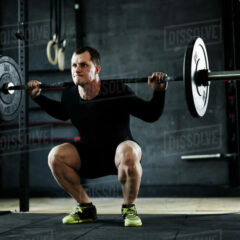https://weightliftingforpower.com/how-to-perform-upper-isometrics-for-maximum-results/
Upper isometric exercises, or Upper Isometrics, focus on contracting muscles in a fixed position without changing the muscle’s length or the joint’s angle. They’re all about holding steady in one spot and letting the tension work. You might not see flashy movements, but this technique has serious power.Believe it or not, when muscles are held under tension without movement, they still get a workout. Isometric holds target muscle fibers in a unique way, forcing them to engage fully. This strengthens not only the targeted muscles but also stabilizes the surrounding areas.One of the main perks of isometrics is efficiency. They maximize muscle activation quickly, perfect for those tight on workout time. They also help increase muscle endurance, improving overall performance in various physical activities.
Isometrics can complement dynamic exercises (those involving movement) rather than replace them. Imagine strengthening parts of your muscles that don’t get hit during regular movements. That’s where isometrics step in, helping create a well-rounded fitness regimen.
Preparing for Upper Isometrics: Essential Guidelines
Getting your body ready for upper isometrics means warming up properly. Skipping warm-ups isn’t an option if you want to prevent injuries. Simple dynamic stretches can do wonders in prepping your muscles for the demands of isometrics.
Proper form is not just a suggestion; it’s crucial for effectiveness and avoiding injury. When you’re holding a position for an extended period, minor errors in form can lead to discomfort or injury. Engage the right muscles, align the spine, and breathe steadily to maintain form.
You don’t always need fancy equipment to do isometrics effectively. Bodyweight exercises like planks are perfect for beginners. However, those seeking an extra challenge can incorporate resistance bands or weights. Making the ideal choice hinges on understanding your fitness level and how it aligns with your goals.
Setting realistic goals is another key step. Start with easier holds or shorter durations, then gradually increase as you get stronger. It prevents discouragement and ensures continuous progress without overexerting yourself. Remember, patience pays off in muscle gains.
Progression Techniques for Maximizing Isometric Gains
When pushing your limits in upper isometrics, consider tweaking duration and intensity. Holding a position a little longer or adding a bit more resistance activates more muscle fibers and really tests your strength.
Repetition might not seem like a focus in isometric holds since you stay still, but the quantity of sets and holds matters. Performing multiple sets with rest in between can enhance muscle endurance and promote strength gains.
Blending isometrics with other workouts adds variety and tackles muscles from different angles. Mixing in weightlifting or cardio can balance your fitness regimen and prevent your muscles from hitting a plateau.
Harnessing technology can transform how you monitor your isometric progress, making achieving your fitness goals easier and more effective. Apps that measure hold time or track consistency help you stay on course with your fitness goals. Progress is motivating, and having a record of your gains assists in fine-tuning your technique.
Personalized Isometric Routines: Crafting The Perfect Plan
Crafting a personalized isometric routine begins with understanding what you want. Are you aiming for strength, endurance, or bouncing back from an injury? Each goal needs a slightly different approach, so identify what you’re after before diving in.
Frequency and recovery are two sides of the same coin. While regular workouts help you progress, rest days let your muscles rebuild and strengthen. Striking a balance between exercise and recovery prevents burnout and promotes safety.
Sample workouts are a great way to get started. Beginners might find holding a plank challenging, while advanced athletes can incorporate weighted holds into their routines. The key is to find exercises that align with your current capabilities.
Listening to your body is non-negotiable. It’s the feedback you need to adjust your plan as you advance. Your shoulders can hold a bit longer, or your legs are aching. Either way, pay attention and make changes as necessary to ensure you’re on the right track toward your fitness objectives.
http://www.Bodyrecomposition.com
https://weightliftingforpower.com/dumbbell-exercise-cards/
https://weightliftingforpower.com/tricep-workouts/
https://weightliftingforpower.com/best-cardio-exercise-to-lose-weight/
https://weightliftingforpower.com/great-tricep-workouts/
https://weightliftingforpower.com/mistakes-to-avoid-on-tricep-


